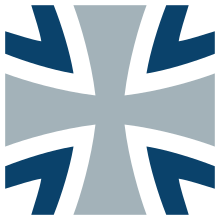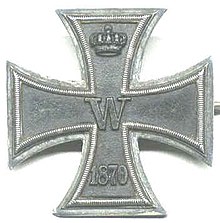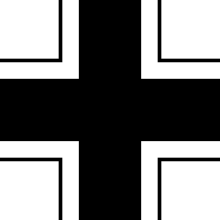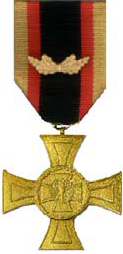Iron Cross

The Iron Cross (Template:Audio-de) was a military decoration of the Kingdom of Prussia, and later of Germany, which was established by King Friedrich Wilhelm III of Prussia and first awarded on 10 March 1813 in Breslau. In addition to the Napoleonic Wars, the Iron Cross was awarded during the Franco-German War, the First World War, and the Second World War.
The Iron Cross was normally a military decoration only, though there were instances of it being awarded to civilians for performing military functions. As an example, the civilian pilot Hanna Reitsch was awarded the Iron Cross First Class for her bravery as a test pilot during World War II.
The Iron Cross was also used as the symbol of the German Army from 1871 to 1915, when it was replaced by a simpler Greek cross. In 1956 the Iron Cross became the symbol of the Bundeswehr, the German armed forces. The traditional design is black and this design is used on armored vehicles and aircraft. A newer design in blue and silver is used as the emblem in other contexts.
Design


The Iron Cross (a black four-pointed cross with white trim, with the arms widening towards the ends, similar to a cross pattée), was designed by the neoclassical architect Karl Friedrich Schinkel and reflects the cross borne by the Teutonic Knights in the 14th century.
The ribbon for the 1813, 1870 and 1914 Iron Cross (2nd Class) was black with two thin white bands, the colours of Prussia. The noncombatant version of this award had the same medal, but the black and white colours on the ribbon were reversed.
Initially the Iron Cross was worn with the blank side out. This did not change until 1838 when the sprig facing could be presented. [1]
Since the Iron Cross was issued over several different periods of German history, it was annotated with the year indicating the era in which it was issued. For example, an Iron Cross from the First World War bears the year "1914", while the same decoration from the Second World War is annotated "1939". The reverse of the 1870, 1914 and 1939 series of Iron Crosses have the year "1813" appearing on the lower arm, symbolizing the year the award was created. The 1813 decoration also has the initials "FW" for King Frederick William III, while the next two have a "W" for the respective kaisers, Wilhelm I and Wilhelm II. The final version shows a swastika.
It was also possible for a holder of the 1914 Iron Cross to be awarded a second or higher grade of the 1939 Iron Cross. In such cases a "1939 Clasp" (Spange) would be worn on the original 1914 Iron Cross. (A similar award was made in 1914 but was quite rare, since there were few in service who held the 1870 Iron Cross.) For the First Class award the Spange appears as an eagle with the date "1939" that was pinned above the Cross. Although two separate awards, in some cases the holders soldered them together.
A cross was the symbol of the Teutonic Knights (a heraldic cross pattée), and the cross design (but not the specific decoration) has been the symbol of Germany's armed forces (now the Bundeswehr) since 1871.
Early awards
The Iron Cross was founded on 10 March 1813 in Breslau and awarded to soldiers during the Wars of Liberation against Napoleon. King Wilhelm I of Prussia authorized further awards on 19 July 1870, during the Franco-German War. Recipients of the 1870 Iron Cross who were still in service in 1895 were authorized to purchase a 25-year clasp consisting of the numerals "25" on three oak leaves. The Iron Cross was reauthorized by Emperor Wilhelm II on 5 August 1914, at the start of the First World War. During these three periods, the Iron Cross was an award of the Kingdom of Prussia, although given Prussia's pre-eminent place in the German Empire formed in 1871, it tended to be treated as a generic German decoration. The 1813, 1870, and 1914 Iron Crosses had three grades:
- Iron Cross 2nd Class (German: Eisernes Kreuz 2. Klasse)
- Iron Cross 1st Class (German: Eisernes Kreuz 1. Klasse)
- Grand Cross of the Iron Cross (German: Großkreuz des Eisernen Kreuzes, often simply Großkreuz)
Although the medals of each class were identical, the manner in which each was worn differed. Employing a pin or screw posts on the back of the medal, the Iron Cross First Class was worn on the left side of the recipient's uniform. The Grand Cross and the Iron Cross Second Class were suspended from different ribbons.
The Grand Cross was intended for senior generals of the German Army. An even higher decoration, the Star of the Grand Cross of the Iron Cross, was awarded only twice, to Field Marshal Gebhard von Blücher in 1813 and to Field Marshal Paul von Hindenburg in 1918. A third award was planned for the most successful German general during the Second World War, but was not made after the defeat of Germany in 1945.
The Iron Cross 1st Class and the Iron Cross 2nd Class were awarded without regard to rank. One had to already possess the 2nd Class in order to receive the 1st Class (though in some cases both could be awarded simultaneously). The egalitarian nature of this award contrasted with those of most other German states (and indeed many other European monarchies), where military decorations were awarded based on the rank of the recipient. For example, Bavarian officers received various grades of that Kingdom's Military Merit Order (Militär-Verdienstorden), while enlisted men received various grades of the Military Merit Cross (Militär-Verdienstkreuz). Prussia did have other orders and medals which were awarded on the basis of rank, and even though the Iron Cross was intended to be awarded without regard to rank, officers and NCOs were more likely to receive it than junior enlisted soldiers.
In the First World War, approximately four million Iron Crosses of the lower grade (2nd Class) were issued, as well as around 145,000 of the higher grade (1st Class).[2] Exact numbers of awards are not known, since the Prussian archives were destroyed during the Second World War. The multitude of awards reduced the status and reputation of the decoration. Among the holders of the 1914 Iron Cross 2nd Class and 1st Class was Adolf Hitler, who held the rank of Gefreiter. Hitler can be seen wearing the award on his left breast, as was standard, in many photographs.
Second World War

Adolf Hitler restored the Iron Cross in 1939 as a German decoration (rather than Prussian as in earlier versions), continuing the tradition of issuing it in various grades. Legally it is based on the enactment (Reichsgesetzblatt I S. 1573[3]) of 1 September 1939 Verordnung über die Erneuerung des Eisernen Kreuzes (Regulation of the renewing of the Iron Cross). The Iron Cross of the Second World War was divided into three main series of decorations with an intermediate category, the Knight's Cross, instituted between the lowest, the Iron Cross, and the highest, the Grand Cross. The Knight's Cross replaced the Prussian Pour le Mérite or "Blue Max". Hitler did not care for the Pour le Mérite, as it was a Prussian order that could be awarded only to officers. The ribbon of the medal (2nd class and Knight's Cross) was different from the earlier Iron Crosses in that the color red was used in addition to the traditional black and white (black and white were the colours of Prussia, while black, white, and red were the colors of Germany). Hitler also created the War Merit Cross as a replacement for the non-combatant version of the Iron Cross.
Iron Cross

The standard 1939 Iron Cross was issued in the following two grades:
- Iron Cross 2nd Class (Eisernes Kreuz 2. Klasse)
- Iron Cross 1st Class (Eisernes Kreuz 1. Klasse) (abbreviated as EKI or E.K.I.)
The Iron Cross was awarded for bravery in battle as well as other military contributions in a battlefield environment.
The Iron Cross 2nd Class came with a ribbon and was worn in one of two different methods:
- When in formal dress, the entire cross was worn mounted alone or as part of a medal bar.
- For everyday wear, only the ribbon was worn from the second hole in the tunic button.
The Iron Cross First Class was a pin-on medal with no ribbon and was worn centered on a uniform breast pocket, either on dress uniforms or everyday outfit. It was a progressive award, with the second class having to be earned before the first class and so on for the higher degrees.
It is estimated that some four and a half million Second Class Iron Crosses were awarded in the Second World War, and 300,000 of the First Class [5]. Two Iron Cross First Class recipients were women, one of whom was test pilot Hanna Reitsch. The only Muslim to have ever received the award, SS Obersturmführer Imam Halim Malkoč, was granted the Iron Cross (Second Class) in October 1943 for his role in suppressing the Villefranche-de-Rouergue mutiny. Two Jewish officers of the Finnish army and one female Lotta Svärd member were awarded Iron Crosses, but they would not accept them.[6]
Knight's Cross of the Iron Cross
The Knight's Cross of the Iron Cross (Ritterkreuz des Eisernen Kreuzes, often simply Ritterkreuz) recognized extreme battlefield bravery or successful leadership. The Knight's Cross was divided into five degrees:
- Knight's Cross (Ritterkreuz des Eisernen Kreuzes)
- Knight's Cross with Oak Leaves (mit Eichenlaub)
- Knight's Cross with Oak Leaves and Swords (mit Eichenlaub und Schwertern)
- Knight's Cross with Oak Leaves, Swords, and Diamonds (mit Eichenlaub, Schwertern und Brillanten)
- Knight's Cross with Golden Oak Leaves, Swords, and Diamonds (mit Goldenem Eichenlaub, Schwertern und Brillanten)
In total, 7,313 awards of the Knight's Cross were made. Only 883 received the Oak Leaves; 160 both the Oak Leaves and Swords (including Japanese Admiral Isoroku Yamamoto (posthumously); 27 with Oak Leaves, Swords and Diamonds; and one with the Golden Oak Leaves, Swords, and Diamonds (Oberst Hans-Ulrich Rudel).
Recipients of the Knight's Cross with Oak Leaves, Swords, and Diamonds
Pilots
- Colonel (Oberst) Werner Mölders (July 15 1941)
- Lieutenant General (Generalleutnant) Adolf Galland (February 28 1942)
- Colonel (Oberst) Gordon M. Gollob (August 3 1942)
- Captain (Hauptmann) Hans-Joachim Marseille (September 3 1942)
- Colonel (Oberst) Helmut Lent (July 7 1944)
- Major Heinz-Wolfgang Schnaufer (October 14 1944)
- Major Walter Nowotny (October 19 1943)
- Colonel (Oberst) Hans-Ulrich Rudel (Diamonds: March 29 1944, Golden Oak Leaves: January 1 1945)
- Major Erich Hartmann (August 8 1944)
- Colonel (Oberst) Hermann Graf (September 16 1942)
Reichsmarschall Hermann Göring never held the Diamonds. He, being one of the first soldiers presented with the Knight's Cross in 1939, was presented with the Grand Cross of the Iron Cross in 1940.
Submarine captains
Submarine captains of the German Navy (Kriegsmarine):
- Captain (Kapitän zur See) Wolfgang Lüth (August 11 1943)
- Commander (Fregattenkapitän) Albrecht Brandi (November 21 1944)
Field Marshals
Field Marshals (Generalfeldmarschälle):
- Erwin Rommel (March 11 1943)
- Albert Kesselring (July 19 1944)
- Walter Model (August 17 1944)
- Ferdinand Schörner (January 1 1945)
Generals and state officials
- Brig. General (Generalmajor) Adelbert Schulz (January 9 1944)
- Waffen-SS Lt. General (SS-Obergruppenführer) Herbert Otto Gille (September 19 1944)
- Lt. General (General der Fallschirmtruppe) Hermann-Bernhard Ramcke (September 19 1944)
- Maj. General (Generalleutnant) Theodor Tolsdorff (March 18 1945)
- Maj. General (Generalleutnant) Dr. Karl Mauss, DDS (April 15 1945)
- Lt. General (General der Panzertruppe) Dietrich von Saucken (May 8 1945))
- Lt. General (General der Panzertruppe) Hermann Balck (August 31 1944)
- Lt. General (General der Panzertruppe) Hasso von Manteuffel (February 18 1945)
- Maj. General (Generalleutnant) Hyazinth Graf Strachwitz (April 15 1944)
- Waffen-SS General (SS-Oberstgruppenführer) Sepp Dietrich (August 6 1944)
- General (Generaloberst) Hans-Valentin Hube (April 20 1944)
Grand Cross of the Iron Cross (1939)
Like the Knight's Cross, the Grand Cross (Großkreuz) was also worn suspended from the collar. The only recipient of the Grand Cross during the Second World War was Reichsmarschall Hermann Göring, who was awarded the decoration on July 19, 1940. The medal is in effect an oversized Knight's Cross. It had the same overall characteristics as the Knights Cross but was much larger, measuring 63 mm in width as opposed to about 44 mm for the Iron Cross and 48.5 mm for the Knight's Cross. It was originally intended to have outer edges lined in gold, but this was changed to silver before the award was presented.
The Grand Cross was worn with a 57 mm-wide ribbon bearing the same colours as the Knights Cross and 2nd Class ribbons. The award case was in red leather with the eagle and the swastika outlined in gold.
The Grand Cross was not a bravery award. It was reserved solely for General Staff officers for "the most outstanding strategic decisions affecting the course of the war". Göring received the Grand Cross for his command of the Luftwaffe during the successful 1940 campaigns against France, Belgium, and the Netherlands (at the same time as he was promoted to Reichsmarschall of the Greater German Reich).
The original Grand Cross that was presented to Göring (personally by Hitler) was destroyed during an air raid on his Berlin home. Göring had extra copies made, one of them with a platinum frame that he was wearing at the time of his surrender to the allies in 1945.
Several times in official photographs, Göring can be seen wearing his Pour le Mérite, Knights Cross, and Grand Cross around his neck at the same time.
Star of the Grand Cross of the Iron Cross (1939)
The Star of the Grand Cross of the Iron Cross (also called Iron Cross with Golden Rays) was meant to be worn like the Iron Cross First class (pinned to the breast.) Like the Grand Cross of the Iron Cross, this award was not intended to be bestowed for bravery. Rather, it was bestowed upon the most successful General officer at the conclusion of a war.
The first Star of the Grand Cross was presented to Gebhard Leberecht von Blücher for defeating Napoleon in the Battle of Waterloo, 1815. That medal is called the Blücherstern (Blücher's Star). The second version of the Star of the Grand Cross of the Iron Cross was presented to Paul von Hindenburg for the German victories over the British in the German offensives in March and April 1918. (See Spring Offensive.) A Star of the Grand Cross of the Iron Cross was manufactured for the Second World War, but it was never awarded. The only known example was found by Allied occupation forces at the end of the war, and was eventually added to the West Point military collection. It is generally believed that Reichsmarschall Hermann Göring was the intended eventual recipient. The design was based on the 1914 version of the Star of the Grand Cross, but with the 1939 Iron Cross as the centerpiece.
Side features of the Iron Cross and entitlements
Officers awarded the Iron Cross were given entitlements and often wore signifying articles, such as an Iron Cross signet ring or cloth Iron Cross which could be affixed to clothing. Also, during the Nazi period, those attaining more than one award, for example, an officer who had attained an Iron Cross 1st class, an Iron Cross 2nd class and the Knight's Cross of the Order of the Iron Cross with the Oak Leaves, were entitled to wear a pin which exhibited three Iron Crosses with an exaggerated swastika, thereby consolidating the awards.
In some cases, Minox miniature cameras were given to people together with an Iron Cross.[7]
It should be noted that, like much World War II memorabilia, the Iron Cross is being counterfeited. It is recommended that purchases be made only from known dealers.
2007 petition to reintroduce the award
In spring 2007 a petition to the parliament (the Bundestag) to reintroduce the Iron Cross as an award for military bravery was initiated. The parliament decided on December 13, 2007 to leave it to the Ministry of Defence to decide on the matter[8]. The proposal was supported by the President of the Reservistenverband, Ernst-Reinhard Beck (CDU). Beck stated that the symbol was used as the symbol of all German military vehicles, airplanes and ships, and constituted a symbol of hope, aid and solidarity in crisis areas[9][10].
On March 6, 2008, President Horst Köhler approved a proposal by Minister of Defense Franz Josef Jung to institute a new award for bravery. The Ehrenkreuz der Bundeswehr für Tapferkeit was instituted on October 10, 2008. However, it does not have the traditional form of the Iron Cross, but is seen as a supplement of existing awards of the Bundeswehr[11].
Post-World War II
Emblem of the German Armed Forces
This section needs expansion. You can help by adding to it. (January 2009) |

The Iron Cross is the emblem of the Bundeswehr, the German armed forces, marked on armored vehicles and aircraft.
German Military Decoration


German law prohibits the wearing of a swastika, so in 1957 the West German government authorised replacement Iron Crosses with an Oak Leaf Cluster in place of the swastika, similar to the Iron Crosses of 1813, 1870, and 1914, which could be worn by World War II Iron Cross recipients. The 1957 law also authorised de-Nazified versions of most other World War II-era decorations (except those specifically associated with Nazi Party organizations, such as SS Long Service medals, or with the expansion of the German Reich, such as the medals for the annexation of Austria, the Sudetenland, and the Memel region).
Since German armed forces began seeing active service again, first in Kosovo and then in Afghanistan, there has been a campaign to revive the Iron Cross and other military medals, since Germany currently has no awards specifically for active military service. In 2007, a petition to the German parliament to revive the Iron Cross decoration received over 5,000 signatures. In October 2008, the German defence minister instead created a new grade of the Ehrenzeichen der Bundeswehr, the Ehrenkreuz der Bundeswehr für Tapferkeit (Honor Cross of the Bundeswehr for Bravery).
The Iron Cross was used as the symbol of the German Army until 1915, when it was replaced by a simpler Greek cross. However, on 1 October 1956 the President of Germany, Theodor Heuss, gave directions to use the Iron Cross as the official emblem of West Germany's Bundeswehr. Today, after German reunification, it appears in the colours blue and silver as the symbol of the "new" Bundeswehr. This design does not replace the traditional black Iron Cross, however, which can be found on all armoured vehicles, planes and helicopters of today's German forces.
When the Quadriga of the Goddess of Peace was retrieved from Paris at Napoleon's fall, the Goddess was re-established atop Berlin's Brandenburg Gate. An Iron Cross was inserted into her laurel wreath, making her into a Goddess of Victory.
See also
- Cross pattée
- List of military decorations
- Military decoration
- Orders, decorations, and medals of Nazi Germany
- Orders, decorations, and medals of Imperial Germany
Similar-looking awards or crosses
- Biker Cross
- Krzyż Powstania Warszawskiego (Cross of the Warsaw Uprising)
- Marksmanship Badge (United States)
- Surfer's cross
Similar crosses
- ☩ Cross of Jerusalem
- ✠ Maltese Cross
- ᛭ Runic alphabet cross punctuation symbol
- Cross potent
- Order of Christ Cross
Similar titled films
Notes
- ^ [1]
- ^ Iron Cross 1st Class
- ^ @ALEX Österreichische Nationalbibliothek Reichsgesetzblatt Teil I S. 1573; 1 September 1939
- ^ GMC. "The Iron Cross". blog entry, 2008 3 18. German Militaria Collectibles. Retrieved 2009 1 2.
{{cite web}}: Check date values in:|accessdate=(help) (EKI = Iron Cross 1st class) - ^ Stephen Previtera, The Iron Time, p. 322
- ^ Juutalaiset Suomen Armeijassa
- ^ Postimees 23 May 2009: Eesti kõige edukamad leiutised
- ^ [2]
- ^ [3]
- ^ http://www.spiegel.de/politik/deutschland/0,1518,539785,00.html
- ^ http://www.faz.net/s/Rub594835B672714A1DB1A121534F010EE1/Doc~E4A28C75C03A14D05B47B13BF98D6B086~ATpl~Ecommon~Scontent.html
References
- Guenther Fraschka, Mit Schwertern und Brillanten, 1955, ISBN 3-8004-1176-8 (this book covers all the 27 recipients of the Diamonds)
- Stephen Thomas Previtera, The Iron Time: A History of the Iron Cross, Second edition 2007, ISBN 978-0-9673070-3-9
- Gordon Williamson, The Iron Cross of 1939, 1997, ISBN 0-912138-86-6
- The 1914 German Iron Cross
